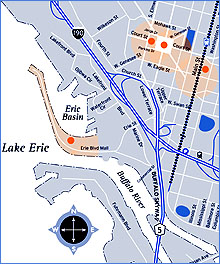Archives
UB informatics students help roll out Wi-Fi zones in Buffalo
By PATRICIA DONOVAN
Contributing Editor
In 2002, Paul Chacko was one of the first graduates of UB's master's-degree program in informatics. Two years later, he's working to produce a boon for downtown Buffalo and the Erie Basin Marina—a series of interconnected Wi-Fi zones.
For the uninitiated, "Wi-Fi" refers to the industry transmission standard for wireless Internet connections. Wireless connections usually cost money and users subscribe to services at a variety of rates.

Downtown Buffalo has a number of new public Wi-Fi zones, thanks to the work of graduate students and faculty members in the School of Informatics.
Public Wi-Fi zones, or "hot spots," are spaces within whose perimeters Wi-Fi enabled digital devices—from palm pilots to laptop computers—can be employed without plugging in and without cost to the user. Because they are so popular with young users, they are a boon to any neighborhood that provides access to them.
Chacko is network administrator for the School of Informatics and a member of its adjunct faculty. As part of a graduate course he taught last semester, 14 students completed a project with BuffaloWiFi.org, a public-private partnership backed by technology companies that will result in the installation of three new wireless fidelity or Wi-Fi zones in downtown Buffalo this summer.
Free hot spots use radio transmitters to offer wireless communication to the masses within a limited range. Each transmitter "enables" an area a few hundred feet in diameter. They can be linked, however, to offer more or less continuous free usage areas.
"Free hot spots have been established in other cities," Chacko says. "Boston, Seattle and New York, for instance, have many of them, but until now, Buffalo had only the one set up last year in Lafayette Square by BuffaloWiFi.org."
The new wireless zones, located in City Hall, Niagara Square and the Erie Basin Marina, link to the existing zone, opening up a "wireless corridor" that runs from City Hall east to Niagara Square and then to Lafayette Square.
"Given the perimeters of the wireless zone," Chacko says, "and depending on the hardware available on their laptops, it's also possible for users to get a free connection in the area from the Liberty Building south to M&T Plaza.
"To connect to the free link," he adds, "the user must first register at http://www.buffalowifi.org/index.smpl?arg=hz_signup. Once registered, he or she can connect to "buffalo_wifi" and log in for a free hour of net surfing or email use.
"Hot-spot enabled Web browsing is limited, however, in the sense that users cannot download music or videos, and filters will block access to pornographic sites," Chacko says. Because the connection is limited to one hour, users who want additional time will have to log in to the "buffalo_wifi" access zones for each additional hour of use.
Before establishing the locations for the hot spots over several freezing weekends in February, the graduate students developed a rough estimate of what needed to be done, what it would cost and how it would be accomplished. They submitted draft plans for the various installations, which helped Thinwires, a local company that specializes in the local and regional installation of wireless hot spots, set up the hardware around Buffalo.
Chacko calls the new zones "a public attraction and a boon for the city of Buffalo."
He points out that today there are about 21,000 hot spots across the United States, 54 of them in and around Buffalo. Most carry connection charges from commercial providers like T-Mobile or iPass, however, and many only are available at a per-hour charge in business establishments from apartment houses to cafes and coffee bars.
"So free public hot spots are very attractive. A lot of people will come downtown to the Buffalo Marina on a beautiful day, for instance, just to be able to work online out-of-doors," Chacko says.
"Boaters who dock in Buffalo now can log in and get an online list of local restaurants and other businesses close to the waterfront, which can bring revenue to Buffalo businesses," he says.
"This technology isn't familiar yet to everyone," Chacko admits, "and Wi-Fi may be an absolutely unknown quantity to some. A lot of young people, however, especially those in college, grad school and business, know exactly what it is and how to use it."
Look for even more public Wi-Fi zones to come in the lobby of the Ellicott Square Building and across the street from the building in Cathedral Park. Plans to stretch connections along parts of Elmwood Avenue—where outdoor cafés proliferate—also are in the works.
Chacko points out that a recent Intel Corp. survey ranked Buffalo 60th among 100 "unplugged" U.S. cities. He notes, however, that the city is up from a rank of 70th the year before, and that the new additions will improve the ranking further. The survey also recognized the UB Libraries and the Buffalo International Airport for the availability of Wi-Fi access.
Internet users can log on to http://www.wi-fihotspotlist.com/, plug in their location and get a list of nearby hot spots—commercial and public, free and fee-for-use—in Buffalo and cities across the country.
BuffaloWiFi.org is led by the Erie County Industrial Development Agency, with backing from corporate sponsors like Verizon and Cisco Systems. Besides the School of Informatics, members include Choice One Online, Thinwires, Computer SOS, Infotech Niagara, ITX Corp. and Buffalo Niagara Enterprise.
